Categories: Novice electricians, How does it work
Number of views: 73724
Comments on the article: 4
Modern heating elements
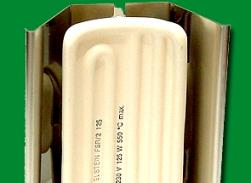 In the article "Electric heating elements" It was told mainly about tubular heating elements - heating elements and open spirals. In addition, there are many other elements, some of which are almost the same age as the open spiral, while others have appeared relatively recently, thanks to the development of modern technologies. About these heaters, new and not very, will be discussed in this article.
In the article "Electric heating elements" It was told mainly about tubular heating elements - heating elements and open spirals. In addition, there are many other elements, some of which are almost the same age as the open spiral, while others have appeared relatively recently, thanks to the development of modern technologies. About these heaters, new and not very, will be discussed in this article.
Infrared heating elements
They are used in various devices, primarily infrared heaters for space heating. Simply put, these are heating appliances that create comfort in a house, apartment, office or workshop. For various conditions, a wide variety of heater designs are used. Infrared heaters can also be used in various technological equipment where heating of certain objects is required.
A striking example of such technological equipment are infrared soldering stations and modern laboratory heating cabinets and furnaces. IR heating is widely used in group soldering of printed circuit boards with SMD components.

Figure 1. Installation of group soldering with IR heating: 1 - exhaust ventilation, 2 - matrix of IR lamps, 3 - board, 4 - IR lamp, 5 - reflector, 6 - cooling device, 7 - conveyor
IR radiation, what it is, and how it works
Infrared radiation is one of the components of the solar spectrum. IR rays are located in the lowest frequency area of sunlight. It is they who bring us warmth to Earth. At the same time, infrared rays pass unhindered through the air without heating it at all. The earth's surface is heated, and everything that is found in the path of sunlight. And only then, air warms from warm objects. This is why the air is cool in the morning until the sun rises. Infrared heaters, which are the basis of industrial and household heaters.
Of course, the range of man-made IR heaters is not as wide as that of sunlight, and is in the long-wavelength region of the IR range with a wavelength of λ = 50–2000 μm. Moreover, the lower the temperature of the heated body, the longer the wavelength. In general, the range of IR radiation is much wider and is divided into three subranges
• short-wave region: λ = 0.74-2.5 microns,
• mid-wave region: λ = 2.5-50 microns,
• long wavelength region: λ = 50-2000 microns,
but infrared heating elements work only in the long-wavelength part of the IR spectrum. Various IR heating elements are the basis for creating infrared heaters. Since the heat from infrared heating elements is transmitted mainly by heat radiation, they are often called infrared emitters.
How are IR heaters arranged?
In fact, the design of the IR heater is simple and unpretentious: the heating element - the radiator is placed in the housing of one or another design, inside the case there is a reflector - reflector, terminals for connecting the radiator, and outside terminals for external wires. Figure 2 shows just such a simple version of the heater.
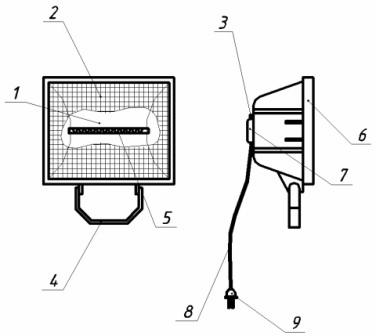
Figure 2. IR heater design: 1 - reflector (reflector), 2 - protective net, 3 - switch, 4 - mounting bracket, 5 - infrared carbon lamp, 6 - cover, 7 - terminal box, 8 - power cord, 9 - fork.
It is immediately evident that the heater of this design is very similar to a spotlight for halogen lamps, used to illuminate advertising, building facades, steps of the porch, part of the yard near the house. In general, a relatively small area, the so-called local lighting.
Therefore, with the help of IR heaters, it is also possible to heat not the entire area of the room, but only some part of it. Energy saving is noticeable to the naked eye: why heat the entire room if you can heat just one corner? An example of individual heating of an office worker is shown in Figure 3.
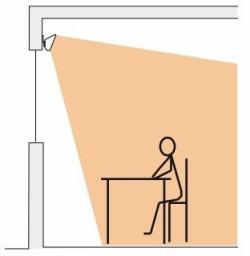
Figure 3. Spot IR heating
This is exactly the heating option that can be obtained using the heater shown in Figure 2. If you want to make heating, for example in a cafe, you will need heaters of a slightly different design that can be installed in the ceiling, like lamps with fluorescent lamps. This option is shown in Figure 4. In principle, heaters can be hung over each table, or simply in a checkerboard pattern.

Figure 4. Full heating
You can find a lot of similar heating schemes, because IR heaters are used to heat quite large rooms: workshops, warehouses, workshops, and even small outdoor areas. For example, it can be a gazebo near the house or a restaurant porch with tables. The infrared heater shown in Figure 2 uses an infrared carbon lamp, what is it, how is it arranged, and what are its properties?
Carbon lamp
It is a vacuum tube made of quartz glass, inside of which there is a radiating element made of carbon (carbon) fiber, more precisely of several fibers twisted into a bundle. Sometimes this radiating element is called a carbon spiral, although this is not entirely correct.
Carbon fiber has appeared relatively recently, but has gained great popularity in various technologies. Not only carbon emitters are made of it. Using special technologies carbon fiber is made of carbon fiber.
The range of applications of carbon plastics is very wide, about twenty directions: from aircraft and rocket technology to strings for musical instruments. Carbon plastics are widely used in the automotive industry, mainly in sports cars. Those who are fond of amateur and sport fishing, appreciated all the charms of carbon rods.
Carbon fiber has a fibrous structure, which significantly increases the radiation area. This area is tens and hundreds of times larger than the area of the spiral of nichrome, tungsten, ceramics, flamentin or other materials. Such a developed area leads to the fact that the heat transfer of carbon fiber is 30 ... 40% higher than that of conventional heating elements.
When voltage is applied, the carbon fiber heats up instantly, immediately the generation of radiant heat begins, and without harmful radiation in the ultraviolet part of the spectrum. Increased heat transfer of carbon fiber leads to a more economical energy consumption than conventional heaters made of nichrome spiral.
With the same power consumption, carbon heaters generate more heat. The heat does not go under the ceiling, as in the case of heating, for example, an oil radiator or a central heating battery.
The optical radiation of carbon lamps is very small. A slightly visible red glow does not affect vision at all, does not blind, but the glow is still noticeable. Figure 5 shows a working household heater based on carbon lamps.
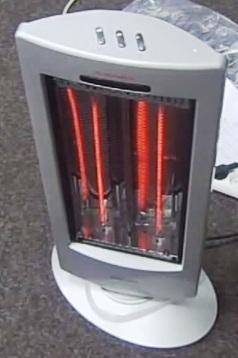
Figure 5. Carbon heater operation
At the top of the heater are switches that set the operating modes. In the stand of the heater there is an electric drive, creating a rocking of the heater in different directions, similar to how the fans do it. With these turns, an increase in the heating area is achieved.
See also on this topic:Interesting facts about infrared heating
Ceramic infrared heaters (emitters)
They are an ordinary heater, "imprisoned" in a ceramic shell - the case. Ceramic is heated by heat from the heater, and already from it, thermal rays are emitted into the external environment. The ceramic shell has an area several times the area of the heater; therefore, heat is given more actively.
The appearance of the ceramic heater is shown in Figure 6. Such heaters are often called panel infrared heaters. The shape of the heating panels is the most diverse. The heater may be flat, concave or, conversely, convex.

Figure 6. Appearance of a ceramic heater
On the front surface, you can consider the configuration of the heater; on the back surface there are wire leads insulated with ceramic beads. The working temperature of ceramic heaters is 700 ... 750 degrees, the specific surface power is up to 64 kW / m2. The power of ceramic heaters can range from several tens of watts to several kilowatts. What is called, for all occasions.
Some types of ceramic heaters have an open, visible coil, such as the HSR type. The operating temperature of the heater is 900 ° C; the heater is designed for quick heating. The appearance of the HSR heater is shown in Figure 7.

Figure 7. HSR Type Heater
Ceramic IR heaters come in three types: volumetric (solid), hollow, as well as heaters with a built-in thermocouple. Volumetric elements are sufficiently inertial, warm up for a long time and cool slowly. In cases where you need periodic on / off heater, hollow heaters are used.
They are less inertial, which allows them to be used in various technological processes, where it is necessary to maintain the exact temperature of the working medium by periodically turning the emitter on / off. Due to the reduced mass, the heating rate of hollow emitters is 40% higher than that of bulk ones.
Unlike bulk emitters, most of the radiation from hollow emitters is directed forward. Radiation back is prevented by a hollow thermal barrier from the rear side, which provides sparing temperature conditions for elements of housing structures, and also increases the efficiency of the emitter. Compared to volume radiators of the same power, the reduction in electricity consumption reaches 15%.
When using a volume radiator, such a heat distribution can only be obtained using a reflector. Some types of panel IR heaters have a built-in thermocouple type K or J, which allows for precise control and regulation of temperature. It is very convenient for use in technological processes.
There are a lot of technological processes where IR emitters are used. Here are just a few of them:
-
Paint drying (two-component paints, epoxy varnishes),
-
Plastics processing (vulcanization of PVC, thermoforming of ABS plastic, polyethylene, polystyrene, parts of an auto body, powder coating)
-
Adhesive drying
-
Food processing (maintaining heated, grilling, sterilization and pasteurization),
-
Textiles (silk screen printing, decals on t-shirts, carpet latexing),
-
Beauty and health (infrared heat booths, saunas)
Edison Infrared Ceramic Lamps
Relate to hollow ceramic emitters, are available with an E27 cap, like a conventional incandescent lamp. This base was invented long ago by the great inventor T. Edison. It is the letter “E” in the name of the cap that immortalizes the name of the inventor, and 27 is the diameter of the cap in millimeters. The design is very convenient: they simply screwed it into a cartridge instead of an incandescent lamp, and immediately it became warm!
It is believed that these heaters are most often used in animal husbandry.Even on Chinese sites with free delivery, from a clumsy machine translation from English, you can understand that these heaters are designed for cowsheds, poultry houses and pigsties.
Why can not such a radiator be hung if not at home, then at least in the workplace? It is far from a secret that our employers do not bother to create normal working conditions: in the summer there is not enough air conditioning, and in the autumn, when the heating has not yet been switched on, you have to put on a cotton padded jacket in the workshop, workshop or in the design department.
Metal reflectors are available for Edison's heaters, which allows to increase heat transfer in the right direction and reduce the thermal effect on walls and ceilings. Actually for the same purposes, reflectors used with other types of heaters also serve. The appearance of the heater with the E27 base is shown in Figure 8.

Figure 8. Edison Infrared Lamp
Naturally, it is necessary to screw such “bulbs” into a high-temperature ceramic cartridge.
Quartz and halogen emitters
They are a sealed vacuum tube made of quartz glass, inside of which there is a spiral of metal with high resistance. In fact, this conventional tungsten halogen lamps. Depending on the design of the spiral, the emitters are divided into two ranges of infrared radiation - medium-wave emitters and short-wave emitters.
In the first of them, the spiral has a star shape, and secondly, inside the quartz tube there is a supported filament, which is perfectly visible through transparent quartz glass. The question is, why make spirals of various designs, what is the result of such technological research?
Halogen emitters with a supported filament operate in the high-frequency range of the IR, and provide the ability to heat up to 2600 ° C. This heating element has a high power, very fast response time, which makes it indispensable in short cyclic processes where high specific power is required.
Heating elements for heating planes
Heating to such high temperatures is far from always necessary, and in these cases it is necessary to use other heaters that transmit heat not by radiation, but in direct contact with the heated object. In this case, the surface of a certain area and shape is heated, both flat and curved. One of these types of heaters is flat elastic heaters made of silicone.
Silicone is an organosilicon polymer composed of silicon and carbon atoms. Depending on the molecular weight, these polymers can be liquid (organosilicon liquids), elastic (organosilicon rubbers) or solid products (organosilicon plastics).
Organosilicon polymers have good dielectric characteristics, are characterized by high heat resistance, good water-repellent properties, physiological inertness, which allows them to be used to create flat heating elements. This design is called silicone heating mats, and is used in cases where uniform heating of any surface is required.
Silicone heating elements
They are a construction of two layers of silicone, between which a heating wire or an etched heating film is placed, which allows you to get a variety of heater parameters. To increase the mechanical strength, silicone is reinforced with textile fiberglass.
These heaters have a high response rate (short heating / cooling time), the accuracy of maintaining the temperature is quite high, especially if the heater is equipped with a temperature sensor and a thermostat.
The geometric dimensions of the silicone mats are small, the thickness of the heaters starts from 0.7 mm, which allows them to be used in a wide variety of areas, ranging from aerospace vehicles and ending with the heating of barrels of oils or paints.
Silicone heaters have increased resistance to moisture and moisture, therefore they are recommended for laboratory equipment, applications in the field of catering, as well as to protect electronic equipment from freezing and condensation. The only restriction on the use of silicone heating elements can be a relatively low operating temperature: 200 ° C in continuous operation and 230 ° C for a short time. The appearance of silicone heaters is shown in Figure 9.
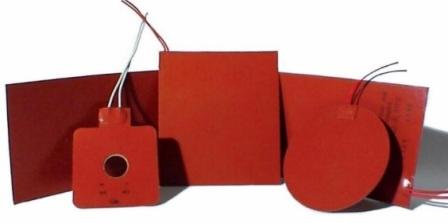
Figure 9. Silicone heaters
The heater from the etched film is shown in Figure 10. Naturally, this conductive path is shown conditionally, in fact, it is covered by another layer of silicone.
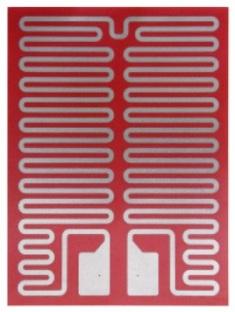
Figure 10
Heaters with etched elements, as well as heaters with a heating wire, are available in a wide variety of shapes and sizes, however, etched elements provide a wide variety of heat distribution schemes. In addition, the large area of the etched heating element provides a higher power density and uniform heat distribution. The distance between the etched conductors can be obtained slightly less than in the case of using a heating wire.
For ease of installation, many silicone heaters on the reverse side are equipped with a self-adhesive film. Modern adhesive technologies make it possible to create durable joints even at elevated temperatures, at which silicone heaters work, so the joint is reliable and durable.
Barrel heaters are often called thermal shirts. The same shirts exist for heating containers, as well as the bottoms of barrels and containers. Naturally, these heaters are flat, and their sizes correspond to the dimensions of barrels or containers. Micanite Heaters
Also apply to flat heating elements. Their basis is micanite - mica paper. Its base is a crumb of natural mica, bonded with a heat-resistant binder. Several layers of such paper are pressed and processed under high pressure and temperature, resulting in plates of the desired size.
To ensure operational qualities and mechanical strength, micanite sandwiches are produced in a thin metal housing, which allows the creation of heaters of various shapes. Figure 11 shows a flat micanite heater and a cuff heater. Such heaters are used in equipment for processing plastics, the melting temperature of which is in the range of 180 ... 240 ° C, which is quite acceptable for micanite heaters.
Figure 11. Micanite heaters
To improve heat transfer, heaters in metal cases are pressed to the heated element with metal brackets and clamps, or even simply tied with wire.
Currently, there are a great many different systems and designs of heaters that allow you to perform any technological tasks. In this article, only a small part of them was described. If someone is seriously interested in this problem, specifically any type of heater, the technology of its application, then such information can always be found in Internet search engines.
See also:Modern household electric heaters
See also at bgv.electricianexp.com
:

